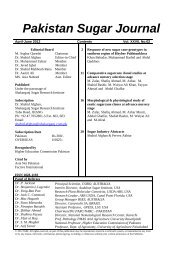Jul-Sep 2012 - Shakarganj
Jul-Sep 2012 - Shakarganj
Jul-Sep 2012 - Shakarganj
Create successful ePaper yourself
Turn your PDF publications into a flip-book with our unique Google optimized e-Paper software.
Shahid Afghan & Pervez Akhtar<br />
results and experience obtained. Another significant result was the first (to our knowledge)<br />
documentation of genotype x country interactions. Somewhat surprisingly, moderate to high<br />
(>0.6) genetic correlations in performance of families and clones between trials in China and<br />
Australia were observed, despite some contrasting environmental and management conditions.<br />
This result supports ongoing collaboration between China and Australia via exchange of<br />
selection trial results and selected germplasm.<br />
Impact of globalization on sugarcane pest’s biodiversity and the environment: a review of<br />
the 2009 entomology workshop<br />
William H. White, Eduardo Willink, Seelavarn Ganeshan, Peter R. Samson and Francois-Regis<br />
Goebel Entomology: Proc. Int. Soc. Sugar Cane Technol., Vol.27, 2010.<br />
The 7 th International Society of Sugar Cane Technologists (ISSCT) Entomology Workshop was<br />
held from 20 to 24 April 2009 in San Miguel de Tucuman, Argentina under the theme; ‘Impact<br />
of Globalization on Sugarcane on Sugar Cane Pests, Biodiversity and the Environment.’<br />
Technical selections held over three days were grouped into five subject headings; biological<br />
control of sugarcane pests; pest management; insect-plant interactions; losses due to sugarcane<br />
pests; and biological studies of sugarcane pests. Following the technical sessions, field trips<br />
allowed delegates to view important insect pests of the Argentine sugarcane industry in the field<br />
and visit the Estacion Experimental Agroindustrial Obispo Colombres, as well as cultural sites in<br />
the region surrounding San Miguel de Tucuman. The Entomology section concluded that<br />
globalisaion will most likely continue to impact on the world’s sugarcane industries. The ISSCT<br />
Entomology Workshops will therefore become increasingly important as a venue for<br />
entomologists to stay abreast of impending insect threats to their industries and to keep current<br />
with new technologies that will be vital for managing potential new invaders as well as<br />
maintaining sustainability.<br />
Sugar losses caused by the sugarcane borer (Diatraea saccharlis) in Tucman, Argentina<br />
A. R. Salvatore, M.B. Garcia, E. Romero and E. Willink Entomology: Proc. Int. Soc. Sugar Cane<br />
Technol. Vol.27, 2010<br />
The sugarcane borer, Diatraea saccharalis is the most damaging pest of the sugarcane in<br />
Tucuman Province. Galleries produced in the stalk by the larvae are gateways to pathogens.<br />
Their effect generates losses in stalk weight, and reduces the quality and amount of sucrose and<br />
juice extraction in factories. The objective of this study was to evaluate the losses caused by<br />
Diatraea saccharalis on three sugarcane varieties and on cane under storage. During the 2005<br />
harvest seasons, observations with three commercial varieties, LCP 85-384, TUCCP 77-42, and<br />
CP 65-357, detected significant losses on field and factory yield. Reductions of 0.42% in the<br />
stalk weight and 0.20% in pol were observed for each 1% attack, producing a 0.22% loss for<br />
each point of infestation loss on the factory yield, with a 620 to 650 g/t of cane loss of sugar,<br />
depending on the variety. In addition, the variety LCP 85-384 was assayed at three different<br />
dates: June, August and October, during the 2006 harvesting season, to evaluate the effect of<br />
storage on losses following D. saccharalis attack. Sugar losses were much greater after 4 days<br />
post harvest storage. This difference was higher as the harvest season progressed.<br />
Pakistan Sugar Journal <strong>Jul</strong>y-<strong>Sep</strong>t. <strong>2012</strong> 26






